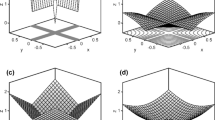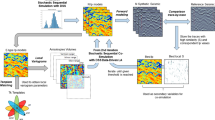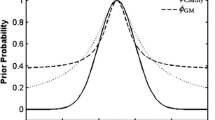Abstract
Prestack seismic inversion can be regarded as an optimization problem, which minimizes the error between the observed and synthetic data under the premise of certain geological/geophysical a priori information constraints. It has been proved to be a powerful approach for reconstructing the subsurface properties and building the elastic parameter models (e.g., P- and S-wave velocity, and density). With respect to the specific expressions of a priori information, the starting model and regularization are expected to be the most widely used and indispensable constraints to reconstruct structural features and subsurface properties. The conventional prestack inversion (trace-by-trace) methods perform well when the geological structure of the target area is not too complex. However, due to the lack of lateral constraint, such trace-independent methods are inevitably limited by their capability of characterization (including accuracy, resolution, and robustness) in the case of geologically complex structures, such as tilted stratum and steep faults. The geological structure-guided constraint, herein referred to as the seismic slope attribute, can be exploited as a lateral constraint integrated into the prestack inversion algorithm. In this work, the seismic slope attribute is introduced to the amplitude variation with offset/angle inversion from two aspects, i.e., starting model building and regularization penalty. Firstly, using the seismic slope attribute, instead of the traditional manual interpreted geological horizons, as a constraint, the well-log data are interpolated to build the initial model. The interpolation algorithm is formulated as solving the inverse problem by using the shaping regularization method rather than the kriging-based algorithm. Secondly, by rotating the coordinate system according to the seismic slope attribute, the directional total variation regularization is used as a constraint to improve the resolution (in both vertical and horizontal directions) and lateral continuity of the inversion results. Finally, the proposed methods are applied to synthetic and real seismic data. Synthetic tests and field data applications demonstrate that the proposed method is capable of revealing complex structural features and achieving stabilized inversion of multi-parameters with less uncertainty.































Similar content being viewed by others
References
Avseth P, Mukerji T, Mavko G (2005) Quantitative seismic interpretation. Cambridge University Press, Cambridge
Azevedo L, Grana D, Amaro C (2019) Geostatistical rock physics ava inversion. Geophys J Int 216:1728–1739
Azevedo L, Nunes R, Soares A, Neto GS, Martins TS (2018) Geostatistical seismic amplitude-versus-angle inversion. Geophys Prospect 66:116–131
Ba J, Xu W, Fu L, Carcione JM, Zhang L (2017) Rock anelasticity due to patchy saturation and fabric heterogeneity: a double double-porosity model of wave propagation. J Geophys Res Solid Earth 122:1949–1976
Bayram I, Kamasak ME (2012a) A directional total variation. Proceedings of the 20th European Signal Processing Conference (EUSIPCO), pp 265–269
Bayram I, Kamasak ME (2012b) Directional total variation. IEEE Signal Process Lett 19(12):781–784
Bhatt JS, Joshi MV (2016) Regularization in hyperspectral unmixing. SPIE Press, Bellingham, WA, USA
Buland A, Omre H (2003) Bayesian linearized AVO inversion. Geophysics 68(1):185–198
Castagna JP, Smith SW (1994) Comparison of AVO indicators: A modeling study. Geophysics 59(12):1849–1855
Charbonnier P, Blanc-Féraud L, Aubert G, Barlaud M (1997) Deterministic edge-preserving regularization in computed imaging. IEEE Trans Image Process 6(2):298–311
Chen H (2020) Seismic frequency component inversion for elastic parameters and maximum inverse quality factor driven by attenuating rock physics models. Surv Geophys 41(4):835–857
Chen H, Zhang G (2017) Estimation of dry fracture weakness, porosity, and fluid modulus using observable seismic reflection data in a gas-bearing reservoir. Surveys in Geophysics 38(3):651–678
Chen J, Zelt CA, Jaiswal P (2013) A case history: application of frequency-dependent traveltime tomography and full waveform inversion to a known near-surface target. 83th Annual International Meeting, SEG, Expanded Abstract, pp 1743–1748
Chen Y, Bai M, Chen Y (2019a) Obtaining free USArray data by multi-dimensional seismic reconstruction. Nat Commun 10(1):4434
Chen Y, Chen H, Xiang K, Chen X (2016) Geological structure guided well log interpolation for high-fidelity full waveform inversion. Geophys J Int 207:1313–1331
Chen Y, Chen H, Xiang K, Chen X (2017) Preserving the discontinuities in least-squares reverse time migration of simultaneous-source data. Geophysics 82(3):S185–S196
Chen Y, Chen X, Wang Y, Zu S (2019b) The interpolation of sparse geophysical data. Surv Geophys 40:73–105
Chen Y, Huang W, Zhou Y, Liu W, Zhang D (2018) Plane-wave orthogonal polynomial transform for amplitude-preserving noise attenuation. Geophys J Int 214(3):2207–2223
Chen Y, Yuan J, Zu S, Qu S, Gan S (2015) Seismic imaging of simultaneous-source data using constrained least-squares reverse time migration. J Appl Geophys 114:32–35
Cheng G, Yin X, Zong Z (2019) Nonlinear elastic impedance inversion in the complex frequency domain based on an exact reflection coefficient. J Pet Sci Eng 178:97–105
Claerbout JF (1992) Earth soundings analysis: processing versus inversion. Blackwell Scientific Publications, New Jersey
Dadashpour M, Landrø M, Kleppe J (2007) Nonlinear inversion for estimating reservoir parameters from time-lapse seismic data. J Geophys Eng 5(11):54–66
Deutsch CV, Journel AG (1994) Integrating well test-derived effective absolute permeabilities in geostatistical reservoir modeling. AAPG Special Volumes
Diaz AGGAE (2012) Constrained full waveform inversion by model reparameterization. Geophysics 77(2):R117–R127
Erik Rabben T, Tjelmeland H, Ursin B (2008) Non-linear Bayesian joint inversion of seismic reflection coefficients. Geophys J Int 173(1):265–280
Fomel S (2002) Application of plane-wave destruction filters. Geophysics 67:1946–1960
Fomel S (2005) A multistep approach to multicomponent seismic image registration with application to a West Texas carbonate reservoir study. 75th Annual International meeting. SEG, Expanded Abstracts 24:1018–1021
Fomel S, Backus M, Deangelo M, Murray P, Hardage B (2003) Multicomponent seismic data registration for subsurface characterization in the shallow Gulf of Mexico. 73th Annual International meeting, SEG, Expanded Abstracts, 781–784
Gan S, Wang S, Chen Y, Chen X, Huang W (2016) Compressive sensing for seismic data reconstruction using a fast projection onto convex sets algorithm based on the Seislet transform. J Appl Geophys 130:194–208
Geman D, Reynolds G (1992) Constrained restoration and the recovery of discontinuities. IEEE Trans Pattern Anal Mach Intell 3:367–383
Geman D, Yang C (1995) Nonlinear image recovery with half-quadratic regularization. IEEE Trans Image Process 4(7):932–946
Geman S, Geman D (1984) Stochastic relaxation, Gibbs distributions, and the Bayesian restoration of images. IEEE Trans Pattern Anal Mach Intell 6:721–741
Grana D, Fjeldstad T, Omre H (2017) Bayesian gaussian mixture linear inversion for geophysical inverse problems. Math Geosci 49:493–515
Grana D, Rossa E (2010) Probabilistic petrophysical-properties estimation integrating statistical rock physics with seismic inversion. Geophysics 75:O21–O37
Greenberg M, Castagna J (1992) Shear-wave velocity estimation in porous rocks: theoretical formulation, preliminary verification and applications1. Geophys Prospect 40(2):195–209
Guo Q, Ba J, Luo C, Xiao S (2020) Stability-enhanced prestack seismic inversion using hybrid orthogonal learning particle swarm optimization. J Pet Sci Eng 192:107313
Guo Q, Zhang H, Cao H, Xiao W, Han F (2019) Hybrid seismic inversion based on multi-order anisotropic Markov random field. IEEE Trans Geosci Remote Sens 58:1–14
Guo Q, Zhang H, Han F, Shang Z (2017) Prestack seismic inversion based on anisotropic Markov random field. IEEE Trans Geosci Remote Sens 56(2):1069–1079
Guo Q, Zhang H, Han F, Shang Z (2018a) Prestack seismic inversion based on anisotropic Markov random field. IEEE Trans Geosci Remote Sens 56(2):1069–1079
Guo Q, Zhang H, Wei K, Li Z, Shang Z (2018b) An improved anisotropic Markov random field approach for prestack seismic inversion. IEEE Geosci Remote Sens Lett 56(2):1069–1079
Hamid H, Pidlisecky A, Lines L (2018) Prestack structurally constrained impedance inversion. Geophysics 83(2):R89–R103
Hestenes MR, Stiefel E (1952) Methods of conjugate gradients for solving linear systems. J Res Natl Bureau Stand 49:409–436
Huang G, Chen X, Li J, Luo C, Wang B (2017) Application of an adaptive acquisition regularization parameter based on an improved GCV criterion in pre-stack AVO inversion. J Geophys Eng 14(1):100–112
Huang G, Chen X, Luo C, Chen Y (2020) Geological structure guided initial model building for prestack AVO/AVA inversion. IEEE Trans Geosci Remote Sens. https://doi.org/10.1109/TGRS.2020.2998044
Huang G, Chen X, Luo C, Li X (2018a) Application of optimal transport to exact Zoeppritz equation AVA inversion. IEEE Geosci Remote Sens Lett 15(9):1337–1441
Huang G, Li J, Luo C, Chen X (2018b) Regularization parameter adaptive selection and its application in the pre-stack AVO inversion. Explor Geophys 49(3):323–335
Jiao J, Lowrey DR, Willis JF, Martinez RD (2008) Practical approaches for subsalt velocity model building. Geophysics 73(5):VE183–VE194
Karimpouli S, Malehmir A (2015) Neuro-Bayesian facies inversion of prestack seismic data from a carbonate reservoir in Iran. J Pet Sci Eng 131:11–17
Korenaga J, Holbrook WS, Kent GM, Kelemen PB, Detrick RS, Larsen H-C, Hopper JR, Dahl-Jensen T (2000) Crustal structure of the southeast Greenland margin from joint refraction and reflection seismic tomography. J Geophys Res Solid Earth 105(B9):21591–21614
Landro M, Digranes P, Stronen L (2001) Mapping reservoir pressure and saturation changes using seismic methods possibilities and limitations. First Break 19(12):671–684
Li C, Zhang F (2017) Amplitude-versus-angle inversion based on the \(l\)1-norm-based likelihood function and the total variation regularization constraint. Geophysics 82(3):R173–R182
Li K, Yin X, Zong Z (2017) Pre-stack Bayesian cascade AVA inversion in complex-Laplace domain and its application to the broadband data acquired at East China. J Pet Sci Eng 158:751–765
Li S (2013) Wave-equation migration velocity analysis by non-stationary focusing. 83th Annual International Meeting, SEG, Expanded Abstract, pp 1110–1115
Li Z, Song B, Zhang J, Hu G (2016) Joint elastic and petrophysical inversion using prestack seismic and well log data. Explor Geophys 47(4):331–340
Liang L, Zhang H, Guo Q, Saeed W, Shang Z, Huang G (2017) Stability study of pre-stack seismic inversion based on the full Zoeppritz equation. J Geophys Eng 14(5):1242–1259
Liu Q, Dong N, Ji Y, Chen T (2018) Direct reservoir property estimation based on prestack seismic inversion. J Pet Sci Eng 171:1475–1486
Liu W, Cao S, Liu Y, Chen Y (2016) Synchrosqueezing transform and its applications in seismic data analysis. J Seism Explor 25:27–44
Luo C, Ba J, Carcione JM, Huang G, Guo Q (2020) Joint PP and PS pre-stack seismic inversion for stratified models based on the propagator-matrix forward engine. Surv Geophys. https://doi.org/10.1007/s10712-020-09605-5
Luo C, Li X, Huang G (2019) Pre-stack AVA inversion by using propagator matrix forward modeling. Pure Appl Geophys 176(10):4445–4476
Mindlin RD (1949) Compliance of elastic bodies in contact. J Appl Mech 16(3):259–268
Noble M, Thierry P, Taillandier C, Calandra H (2010) High-performance 3d first-arrival traveltime tomography. Geophysics 29:86–93
Oezsen R (2004) Velocity modelling and prestack depth imaging below complex salt structures: a case history from on-shore Germany. Geophys Prospect 52:693–705
Osypov K (2000) Robust refraction tomography. 70th Annual International Meeting, SEG, Expanded Abstract 19:2032–2035 SEG. Expanded Abstract. 19:2032–2035
Pan X, Zhang G (2018) Model parameterization and PP-wave amplitude versus angle and azimuth (AVAZ) direct inversion for fracture quasi-weaknesses in weakly anisotropic elastic media. Surv Geophys 39(5):937–964
Pan X, Zhang G, Cui Y (2020) Matrix-fluid-fracture decoupled-based elastic impedance variation with angle and azimuth inversion for fluid modulus and fracture weaknesses. J Pet Sci Eng 189:106974
Pan X, Zhang G, Yin X (2018a) Azimuthal seismic amplitude variation with offset and azimuth inversion in weakly anisotropic media with orthorhombic symmetry. Surv Geophys 39(1):99–123
Pan X, Zhang G, Yin X (2018b) Elastic impedance variation with angle and azimuth inversion for brittleness and fracture parameters in anisotropic elastic media. Surv Geophys 39(5):965–992
Pereira P, Calcoa I, Azevedo L, Nunes R, Soares A (2020) Iterative geostatistical seismic inversion incorporating local anisotropies. Comput Geosci 24:1589–1604
Pérez D, Velis D, Sacchi MD (2017) Three-term inversion of prestack seismic data using a weighted \(l\)2, 1 mixed norm. Geophys Prospect 65(6):1477–1495
Piatanesi A, Tinti S, Pagnoni G (2001) Tsunami waveform inversion by numerical finite-elements Green’s functions. Nat Hazards Earth Syst Sci 1:187–194
Qu S, Verschuur D (2016) Simultaneous time-lapse imaging via joint migration and inversion. 78th Annual International Conference and Exhibition, EAGE, Extended Abstract 2016
Qu S, Verschuur D, Chen Y (2017) Full waveform inversion using an automatic directional total variation constraint. 79th Annual International Conference and Exhibition, EAGE, Extended Abstract
Qu S, Verschuur E, Chen Y (2019) Full-waveform inversion and joint migration inversion with an automatic directional total variation constraint. Geophysics 84(2):R175–R183
Sen M, Roy IG (2003) Computation of differential seismograms and iteration adaptive regularization in prestack waveform inversion. Geophysics 68(6):2026–2039
Tarantola A (2005) Inverse problem theory and methods for model parameter estimation. SIAM Press, Philadelphia, p 89
Terzopoulos D (1986) Regularization of inverse visual problems involving discontinuities. IEEE Trans Pattern Anal Mach Intell 4:413–424
Thiran JP (1971) Recursive digital filters with maximally flat group delay. IEEE Trans Circuit Theory 18(6):659–664
Velis DR (2005) Constrained inversion of reflection data using Gibbs’ sampling. J Seism Explor 14(1):31
Vidal S, Longuemare P, Huguet F (2000) Integrating geomechanics and geophysics for reservoir seismic monitoring feasibility studies. Society of Petroleum Engineers SPE European Petroleum Conference. No. 10
Wang B, Kim Y, Mason C, Zeng X (2008) Advances in velocity model-building technology for subsalt imaging. Geophysics 73(5):VE173–VE181
Wang E, Carcione JM, Ba J, Liu Y (2020) Reflection and transmission of plane elastic waves at an interface between two double-porosity media: effect of local fluid flow. Surv Geophys 41:283–322
Xue Z, Chen Y, Fomel S, Sun J (2016) Seismic imaging of incomplete data and simultaneous-source data using least-squares reverse time migration with shaping regularization. Geophysics 81(1):S11–S20
Zelt C, Barton P (1998) Three-dimensional seismic refraction tomography: a comparison of two methods applied to data from the Faeroe basin. J Geophys Res 103:7187–7210
Zhang F, Dai R, Liu H (2015) High order approximation for scattering matrix in layered elastic medium and its application in pre-stack seismic inversion. J Pet Sci Eng 131:210–217
Zhang H, Guo Q, Liang L, Cao C, Shang Z (2018) A nonlinear method for multiparameter inversion of pre-stack seismic data based on anisotropic Markov random field. Geophys Prospect 66(3):461–477
Zhang H, Shang Z, Yang C (2007) A non-linear regularized constrained impedance inversion. Geophys Prospect 55(6):819–833
Zhang R, Castagna J (2011) Seismic sparse-layer reflectivity inversion using basis pursuit decomposition. Geophysics 76(6):R147–R158
Zhi L, Chen S, Li X (2016) Amplitude variation with angle inversion using the exact zoeppritz equations - theory and methodology. Geophysics 81(2):N1–N15
Zong Z, Yin X, Wu G (2015) Geofluid discrimination incorporating poroelasticity and seismic reflection inversion. Surv Geophys 36(5):659–681
Acknowledgements
This work was supported by the National Natural Science Foundation of China (42004111, 41774131, 41774129), the China Postdoctoral Science Foundation under Grant 2020M681860 and 2019M661716.
Author information
Authors and Affiliations
Corresponding author
Additional information
Publisher's Note
Springer Nature remains neutral with regard to jurisdictional claims in published maps and institutional affiliations.
Appendices
Appendix A: The Exact Zoeppritz Equation
Without loss of generality, the forward problem of seismic wave propagation can be expressed as a nonlinear equation as follows:
According to the convolution theory, the seismic data can be considered as the convolution between the stationary wavelet and reflectivity: Then, the P–P seismic data can be simulated by convolving the P–P reflectivity coefficient with the stationary wavelet as:
With respect to the prestack seismic inversion, the reflectivity coefficients can be obtained by the Zoeppritz’s equation. When a plane-wave propagates onto a surface, according to the Zoeppritz’s equation, the reflection and transmission coefficients can be expressed as:
where
where \({\textit{v}_{p1}}\), \({\textit{v}_{s1}}\), and \({\rho _{1}}\) denote the elastic parameters of the upper layers, and \({\textit{v}_{p1}}\), \({\textit{v}_{s1}}\), and \({\rho _{2}}\) correspond to the counterpart of the lower layers, \(\theta _{1}\) and \(\phi _{1}\) are the angles of the P- and S-wave reflections, and \(\theta _{1}\) and \(\phi _{1}\) stand for the angles of P- and S-wave transmissions.
The partial derivative with respect to the parameter m can be expressed as:
Appendix B: The Hertz–Mindlin Model
The Hertz–Mindlin contact model (Mindlin 1949) calculates the bulk and shear modulus of two spherical grains in contact. It appears to be the most commonly used contact model to describe seismic parameter changes caused by the pressure changes (Dadashpour et al. 2007). Although the Hertz–Mindlin contact model is proved to be only applicable to perfect elastic contacts of spherical bodies, it works fairly well for sandstones (Avseth et al. 2005). According to he Hertz–Mindlin theory, the effective bulk modulus and shear modulus of a dry random identical sphere packing can be expressed as
where \(\textit{K}_{H\text {-}M}\) and \(\textit{G}_{H\text {-}M}\) indicate the bulk and shear modulus calculated by the Hertz–Mindlin model, \(\phi _{c}\) denotes critical porosity, \(\textit{P}_{\text {eff}}\) represents the effective pressure, and \(\textit{G}\) and \(\nu\) are the shear modulus and Poisson’s ratio of the solid grains, respectively. n is the coordination number and c denotes the average number of contacts per sphere. In the original Hertz–Mindlin theory, n is equal to 3, which indicates that the variation in velocity is proportional to the 1/6 power of \(\textit{P}_{\text {eff}}\).
Some laboratory measurements of samples gave a larger number for n. Vidal et al. (2000) found \(\textit{n}=5.6\) for P-wave and \(\textit{n}=3.8\) for S-wave for gas-saturated sands, while Landro et al. (2001) used \(\textit{n}=5\) for oil-saturated sands.
Rights and permissions
About this article
Cite this article
Huang, G., Chen, X., Li, J. et al. The Slope-Attribute-Regularized High-Resolution Prestack Seismic Inversion. Surv Geophys 42, 625–671 (2021). https://doi.org/10.1007/s10712-021-09636-6
Received:
Accepted:
Published:
Issue Date:
DOI: https://doi.org/10.1007/s10712-021-09636-6




